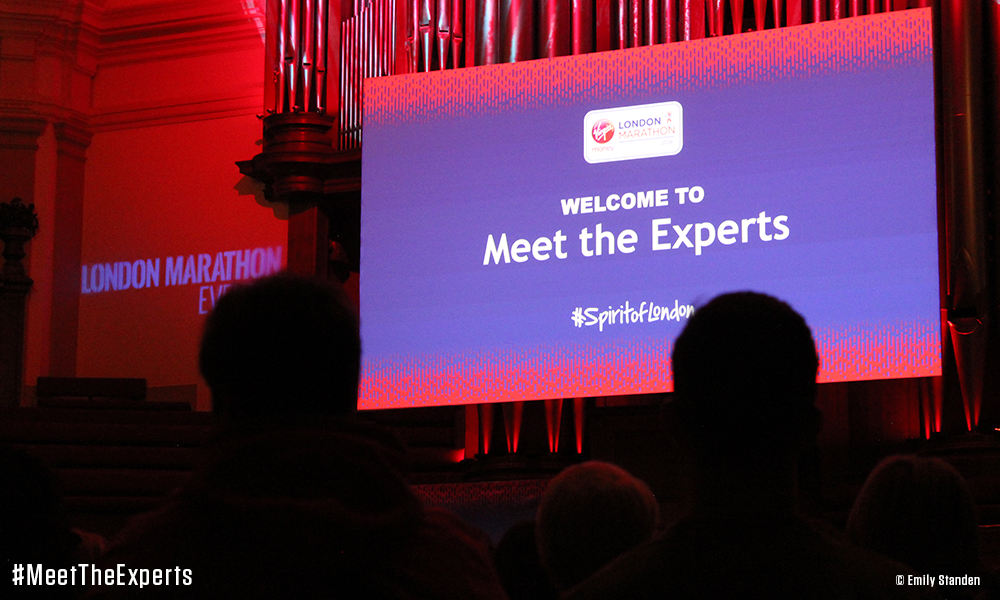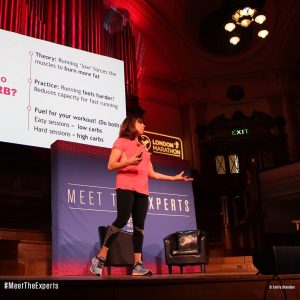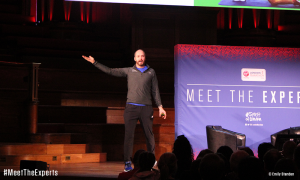at the Methodist Central Hall, Westminster, 3rd February

The organisers of the Virgin Money London Marathon put on an event called “Meet the Experts”, an opportunity to hear from a range of experts to help those attending (almost exclusively first timers such as myself) to be better prepared by the time we get to 22nd April, as well as entertaining and inspiring us with some noteworthy previous runners. I got a free ticket through my charity, Guide Dogs. I wasn’t sure it was going to be worth trekking into London, but it proved to be very worthwhile.
Before the main session in the lecture hall, I had my feet measured for the first time in many, many years, and possibly the first time with such precision. My right foot is a 9.6 and my left a 10.4; my right is slightly wider than normal and my left about normal; my right is more arched than my left. I had my gait analysed, though with such a short runway, rather than a treadmill, I’m not sure how representative it was: the sponsors New Balance then tried to sell me new shoes based on their analysis, but nothing seemed quite right, and this close to the marathon it’s probably best to stick to what I know anyway. I already have four pairs of running shoes in action at the moment, which should be enough.
So, in addition to the entertainment and inspiration from some of the speakers, what did I learn today? Lots of little bits and pieces, some relevant to the next 11 weeks, others to the day itself. Quite a few things weren’t new to me, but hearing them afresh should stimulate me to do something about them. Though I may have mentally absorbed a few other things too, here’s what I noted down, together with some actions or notes to myself:
- Lucozade Sport is available at five points on the route (miles 7, 11, 15, 19 and 23) – start drinking it during my longer runs, to make sure my stomach can take it and that I have a clear nutrition strategy for the race. [First test on 4th February showed no problem drinking it in principle, but I really don’t want to down 500ml in one go. I did one bottle in four quarters, spread over 3km. Probably want a running belt that can carry the Lucozade Sport? Do I still have my old blue one? If so, try it out as not used for a while now. Is it big enough to hold my new phone – probably not.]

- Lucozade Sport gels are at 14 and 21 miles – try Lucozade gels, as the combination of the Lucozade drink and gels would mean I would need hardly any gels of my own. In some ways I’d like to avoid having a running belt at all, but it is handy for phone, gels and handkerchief – and see point above about Lucozade Sport.
- Toilets are available every 2 miles from mile 1 – I hope not to need them, but it’s reassuring to know the option is there (regularly)
- Baggage lorries close at 0925. Only the official kitbag will be accepted, but I don’t know how big that is. Get to the start in lots of time – allow time for baggage lorry and multiple visits to the loo!
- Discarded clothing at the start goes to charities – look out for something warm that we don’t mind losing, plus bin bag if any chance of rain or excessive wind.
- Wheelchair start is 0855, with para-athletes at 0900 and women’s elite race at 0915, so things for spectators to see before the men’s elite and mass race reaches them.
- Mobile phones may not work near the finish (and perhaps the start) due to the volume of people – don’t rely on them for meeting friends/family
- The meeting points are very busy to get to – it may be better to arrange to meet elsewhere, most obviously at the Guide Dogs place
- Three critical things to remember: bag, tag, number
- The routes around the west side of Docklands which look as though they pass each other are actually on different levels, though still potentially provide opportunity for very short walk between viewing spots.
- Good spectator option is to start spectating near Canada Water (or Bermondsey), and then after I’ve passed, get Jubilee Line train to Canary Wharf, from where walk to where can see again (possibly even twice more). Trains will be very busy – be mentally prepared for queues and waiting. Then either to meeting area or to the Embankment – if the latter, don’t go too near Westminster as very busy.
- There are Runners World pacers – in 2017 at any rate, the relevant options for me would be 3h56, 4h15 and 4h30. At the moment I don’t have a target finish time (I have a range: 3h59 to 4h26). Unless I can get near one at the start, there’s little point, and there is a danger that I run too fast (or even too slow). Also, I don’t know which starting pen I will be in (I’ve no recollection of what I put as my estimated finish time) but I’d need to be in the same pen as the relevant pacer otherwise we’d be too widely separated. In next 76 days, get clearer idea of target pace – think in terms of target pace, not target finish time for now.
 #SpiritOfLondon is this year’s official hashtag
#SpiritOfLondon is this year’s official hashtag- Get my name printed on my t-shirt – find out how!
- Think about what I will eat in the morning of the race (particularly as most of my long runs are done first thing in the morning, without significant food). Early breakfast (but what?). Pre-run snack: banana? (Yoghurt, toast with cheese, etc. may be ok before training, but less practical before the race.)
- Suggested to drink 400-800ml per hour. Five full Lucozade Sports is within that for four hours, so may not need much else if I get them all down me. When I tested myself, I found I lost 2.5l in a two hour half-marathon, so 5l in a marathon which suggests I should be drinking at the upper end of that range.
- The most common reason for people dropping out is drinking too much water.
- Only 500 people drop out – nearly 99% of people who start, finish.
- Around 500 people who collect their number etc. in the four days before the race, fail to start. I wonder why?
- I will be going from the Red Start. If I come in from Kent, as I’m currently planning to do, I will be able to walk from Blackheath if that looks the best train option, though Maze Hill and Greenwich are the official stations for the Red start – but there will be no barriers to prevent me walking through from Blackheath.
- Recovery food after long runs: fluid (milk, greek yoghurt, recovery drinks); carbs; high protein (for each meal during the day after the long run).
- Avoid hitting the Wall – it’s not inevitable. Have a race day nutrition plan, carb load for the 2 days prior to the race, taper properly, run at a consistent sensible pace
- Don’t start too fast. Don’t start too fast. Don’t start too fast. Don’t start too fast.
- Runners knee exercises – investigate exercises to strengthen appropriate muscles. Look at other strengthening exercises though experience to date suggests knee is most vulnerable and other common problems haven’t bothered me so far.
- Investigate books by Paul Hoborough [bought one], Vassos Alexander [put on wish list for now], Ben Smith (in April) [put on wish list for now]
- Investigate Marathon Talk website/podcasts (Martin Yelling) [most recent two now downloaded ready to listen to]
- Give more consideration to psychology of running – a good proportion of success is mental. [I’ve bought two books.]
- Identify a mantra for me, e.g. “That medal is mine”, “I will succeed”; and when necessary say it to myself over and over
- Work on visualisation – for example, imagine myself crossing the finish line (and possibly a time?)
- Work on distraction – think about afterwards, about Facebook messages I’ll post, identify the best banners seen, the best costume, attractive runners
- Smile while running – it reduces perceived effort and increases running efficiency
- Plan in advance my tactics for dealing with the mental challenges of the day
- Be as prepared as possible with all the details of the day, so that all the focus is purely on running
- My race preparation is well ahead of many people – keep positive.
